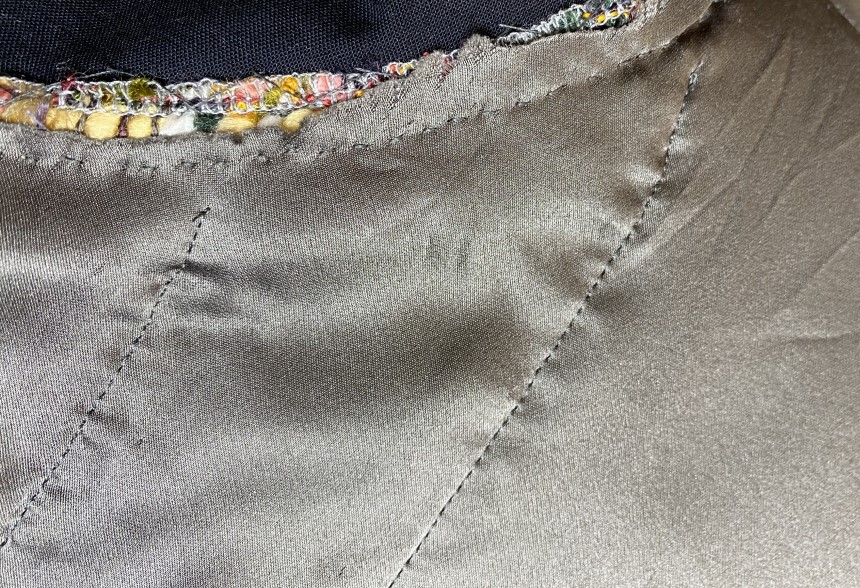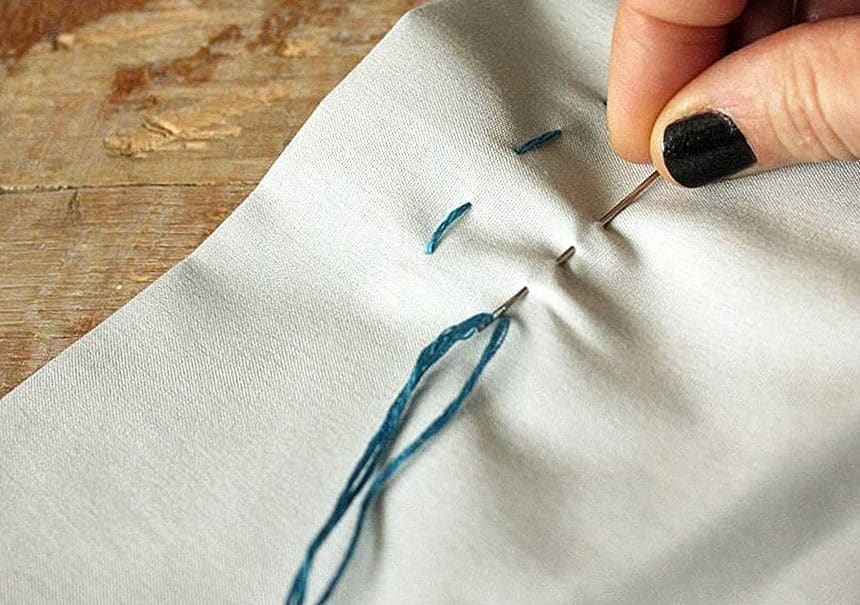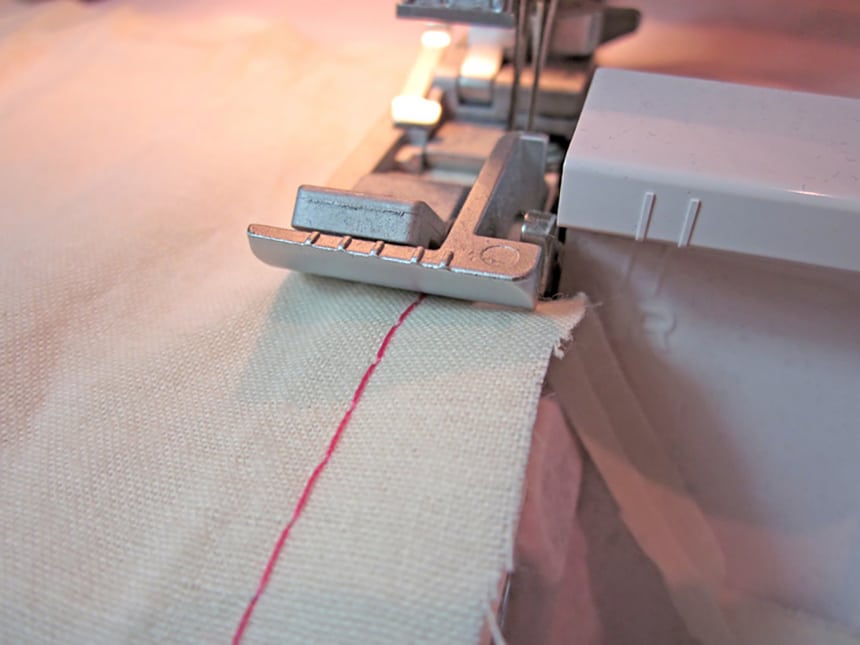

It is very common to hear sewing machine shoppers ask their vendor whether the intended purchase comes with a basting stitch. The stitch is one that you will repeatedly use to tackle new projects and crafts hence why it is so important to buyers. So how do you do a basting stitch on your sewing machine? Is it possible to do one by hand? What is the purpose of the basting stitch? Are there alternatives that you can use? These are some of the questions that we’ll be answering below.
The most basic explanation of a basting stitch is one used to hold tricky seams in place. However, you’re not supposed to leave the fabric with a basting stitch. Instead, it’s a temporary solution that you’ll have to remove once you use a more permanent stitch with examples such as backstitch, whip stitch, overcast stitch, or more.
It’s common practice for people to unpick the basting stitch once they’re done with it.
 As mentioned above, the most common use of the basting stitch is to hold tricky or difficult seams in place. One example is when you’re stitching silk. The material slips around a lot under the sewing machine, and the seam will likely come out of alignment.
As mentioned above, the most common use of the basting stitch is to hold tricky or difficult seams in place. One example is when you’re stitching silk. The material slips around a lot under the sewing machine, and the seam will likely come out of alignment.
However, if you hold it together using a basting stitch, you eliminate some of that motion, and the resulting seam is neater. It should also make the whole stitching process a lot easier. Silk is just one example of a problematic fabric, although there are others that you’ll encounter as well.
Another example is when you’re adding zippers to your fabrics. For these kinds of jobs, you sew near the teeth without touching them; otherwise, you ruin the project and the needles you’re using. To ensure the zipper doesn’t wiggle, you can add a basting stitch before you sit down to fasten it permanently to your fabrics.
Also, when you’re working on projects that require gathered fabric, this stitch could be one crucial tool in your arsenal. Some projects like gathered skirts, dresses, and more may be trickier to pull off if you don’t have a basting stitch to help you out.
Lastly, the basting stitch is used by professional tailors when they fit their designs on their clients. This shows them what the final product will feel and look like when it is finished. Also, no rule says you can’t baste with your hands or with a machine. You just use the sewing tools that are most available to you at the time of your project.
 You should learn to do a basting stitch by hand even if you have a sewing machine on standby. Some of the craft projects you take on may limit you from using the machine. As such, it’s good to have some hand stitching skills as a backup. Also, the stitch is not a difficult one, even for amateurs and beginners.
You should learn to do a basting stitch by hand even if you have a sewing machine on standby. Some of the craft projects you take on may limit you from using the machine. As such, it’s good to have some hand stitching skills as a backup. Also, the stitch is not a difficult one, even for amateurs and beginners.
First, get a hold of an all-purpose needle and thread. The MILIJIA 50Pcs sewing threads have been hailed by reviewers as excellent threads for these kinds of projects. Also, they work well and easily with a machine since they come with pre-wound bobbins. Make sure the thread is made of high-quality polyester as well.
You might need to double thread for most fabrics since you want the stitch to be visible. This is also why you’re advised to use thread with a contrasting color to your fabric. If, however, your project involves ultra-fine fabrics, you want to use only a single thread. This keeps the holes in the fabric small and the workpiece neat.
Anchor the end of the thread to the fabric using a small knot. We’re assuming that you already have the fabrics you need to baste aligned at the edges. You will push the needle through the underside of the fabrics and into the top side. After that, you will push the same needle through the top side of the fabric until it comes out on the underside.
This is the same motion that you do for a running stitch Trusted Source Straight stitch - Wikipedia The straight or running stitch is the basic stitch in hand-sewing and embroidery, on which all other forms of sewing are based. The stitch is worked by passing the needle in and out of the fabric at a regular distance. All other stitches are created by varying the straight stitch in length, spacing, and direction. en.wikipedia.org . However, there is a slight difference. The stitches this time around are much broader. Most hand-basting stitches range in size between ¼” – ½”. However, you can make yours smaller if you want to.
Notably, if you use smaller basting stitches, you will have more control over the workpiece. Depending on the project, you may want to be more precise with your stitches, or you may do a rough stitch. For the former, you’ll have to go through one stitch at a time. Additionally, a marked line may help keep your stitches straight.
However, with a rough basting stitch, you can do several of them at once by bunching up the fabric and pushing the needle through the different layers at once. This will, of course, take practice and shouldn’t be your go-to as you’re starting. When you’re done, secure the knot with a backstitch. Remember that you want the thread to come off easily, and a knot on two ends may be a slight hindrance.
 You can also pull off a basting stitch using a sewing machine quite easily. However, if you’re using a machine, you’re better off using the stitch on straight pieces of fabric. Also, in addition to the machine, needle, and thread, you’ll need sewing pins in your toolkit as well. These will secure the edges of the fabric before you finish with your stitch.
You can also pull off a basting stitch using a sewing machine quite easily. However, if you’re using a machine, you’re better off using the stitch on straight pieces of fabric. Also, in addition to the machine, needle, and thread, you’ll need sewing pins in your toolkit as well. These will secure the edges of the fabric before you finish with your stitch.
First, change the foot of the machine to an all-purpose option. Next, change the stitch settings on the machine to a straight stitch. When you’re done with that, adjust the stitch size to the largest available option. Most machines have at least a 4mm stitch length, although some go as broad as 9mm.
Remember to loosen the stitch as well. A contrasting thread color makes the stitch easier to spot, so use that as well. The reason why you’re using a long loose stitch is that it unpicks easily. You just need to pull on the loose end of the thread once you’re done putting in the final stitch.
Also worth mentioning is that there is a difference between the settings for a regular sewing machine and a computerized alternative. The computerized option should have a basting stitch programmed into the machine in addition to the other types of stitches. Additionally, there should be an automatic and manual version of the basting stitch as well.
The former works the same as the one on regular machines. You pick the length of the stitch plus the tension and let the machine do its magic. If you’re looking to finish up quickly with the basting stitch, this is the option to pick. The manual variation, on the other hand, requires a lot of your input and time. Before you even try it, you need to switch to a darning foot on your machine.
Unlike the other stitches where the machine advances the fabric, this time, it will be you doing the pushing. Consequently, how wide or small the basting stitches end up is dependent on how you move the fabric.
If you’re not sure about sewing machines for basting, SINGER remains a popular brand, and their SINGER 7258 computerized option with its many accessories is just one of the reasons. The programmable needle in this device should be handy not just for basting but for the 100 stitch types included in the design.
How you remove a basting stitch will depend on whether you did it by hand or by machine, in addition to the length of the stitches. Shorter stitches are the trickier to remove, while the long ones just come off without much persuasion.
For the longer stitches, you’ll unpick the ends using a seam ripper and then tug on one side. This should pull the thread right off the fabric. If you’ve used smaller stitches, whether by the machine or by hand, they might not come off as easily. Nevertheless, you still need to use the seam ripper on the two ends of the thread. After that, make a few other cuts on the stitching line before pulling the threads out.
The bits of thread left behind can easily be cleaned with a lint roller.
 Since the basting stitch is just a way to hold fabrics together, there are some alternatives to it as well. One is the use of pins. You can line them up on the edge of the fabric and insert them vertically. When you get to the final stitch, you’ll need to remove them section by section, so you don’t sew through them with the machine. After all, doing this would only damage your equipment.
Since the basting stitch is just a way to hold fabrics together, there are some alternatives to it as well. One is the use of pins. You can line them up on the edge of the fabric and insert them vertically. When you get to the final stitch, you’ll need to remove them section by section, so you don’t sew through them with the machine. After all, doing this would only damage your equipment.
Wonder clips are another alternative. These are especially useful if you have bulky seams that the basting stitch doesn’t support very well. Tailors have also used double-sided and iron-on tapes to great success. They keep the fabrics steady the whole time as you sew through your project.
The last alternative is basting spray that makes it so much easier on users. All you need to do is spray between the fabrics, and they will stick together until you’re done. The Odif Basting Spray is an excellent temporary adhesive, and reviewers have used it on their fabrics to great success. However, there is a warning to be extra careful as the spray is flammable.
Any crafter and tailor worth their salt will know the importance of the basting stitch and why they should know how to do it. Now you do too. All that’s left is to put it into practice. As stated above, it takes a few minutes to learn, and the benefits will carry you through your crafting hobby for as long as you need them to. All the best with your crafts.